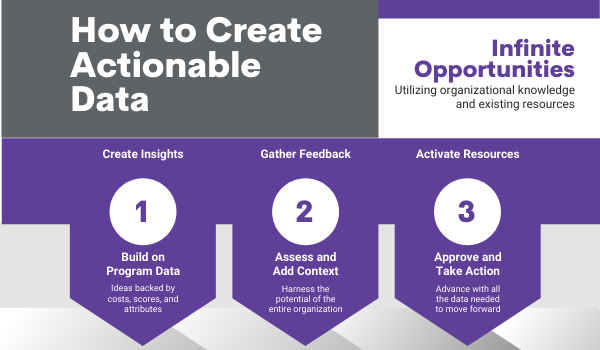Human-induced climate change1 is already having a global impact. We see regular evidence of this in the form of increasingly powerful hurricanes, uncontrollable wildfires, record-breaking high- and low-temperatures, and other extreme weather events.
To help mitigate tomorrow’s climate crisis, many local governments are preparing for the impact of climate change today while at the same time taking steps to reduce its contributing factors.
Before government leaders can implement climate change initiatives, they need interdepartmental support and money allocated to these projects and services in the budget. Climate budgeting is an effective way for state and local governments to prioritize and finance their climate plans.
The Ambition Gap
In January 2023, ICLEI-Local Governments for Sustainability USA published a policy brief titled, The Ambition Gap: From Intent to Implementation in Local Climate Action. The premise of this policy brief is to recognize that while many local governments are sincere and dedicated to climate and sustainability planning, many more face challenges in activating their climate action efforts. A core challenge is a lack of budget to fund climate action.
As ICLEI USA Executive Director Angie Fyfe writes, “...gaps in municipal activation of climate action efforts remain. Too many local governments feel stymied by an ‘analysis and planning cycle’ that occupies time and resources that could be applied to program implementation. An identified gap is the need for better coordination and awareness of climate activities with budget and purchasing processes. Municipalities have a unique set of policy, budget and procurement tools that can advance meaningful climate action. Fostering intentional collaboration between sustainability, budget and procurement officers can yield a whole of government approach to climate action and prepare municipalities to better use their financial capabilities to address climate change.
Leveraging existing resources through municipal and county budgets provide a critical starting point and an immediate opportunity to make critical climate investments and mitigate the accumulating costs associated with weather-born events. By aligning resources, staffing, and priorities across departments, local governments can maximize this unprecedented moment of federal investment in community decarbonization and resilience.
Altogether, these findings point toward a whole-of-government approach to budgeting paired with advanced, delivery-oriented project management as the recipe for fully seizing this climate opportunity.”
Why Every Local Government Needs a Climate Budget
A global climate budget is “a systematic approach or governance system that ensures the carbon budget, or long-term emissions reduction target, is integrated into a city’s daily operations and policies.”
In other words, it helps state and local governments make the climate a decision driver across departments, prioritize the climate in spending plans, and turn climate-focused proposals into financed action items.
From a broader community perspective, a climate budget creates accountability for implementing climate change mitigation efforts by raising public awareness of those efforts.
How Climate Budgeting Affects Climate Action Plans
A climate action plan (CAP) is a science-backed strategy that defines how a local government will reduce greenhouse gas emissions.
CAPs are used to identify the most cost-effective approach to reducing emissions in a region. However, the plan may also include clean energy targets, resilience strategies, social goals, and economic goals. A CAP is essentially the framework that supports the plan’s action items, including directives that address climate changes that are already occurring in specific regions.
ICLEI USA has identified six phases of climate action execution in local government:
- Discovery: the development of the GHG inventory and identification of climate risks, opportunities and threats.
- Planning: the creation of the climate action plan that guides activities of either mitigation, adaptation or both.
- Scoping: the design of specific activities originating from the climate plan.
- Budgeting: integration of climate action and resource allocation to support the climate plan through revenue streams, or new financial structures.
- Procurement: purchasing or selecting specific tools, infrastructures or human resources to support the delivery of the climate plan
- Delivery: execution of a project task, process or asset allocation identified in the climate plan.
Climate budgeting supports climate action planning efforts by:
- Allocating funds to the CAP by scoring programs based on alignment with priorities.
- Embedding climate targets, measurements, and action items into the regular annual budget.
- Providing insight into options to free up or reallocate resources and generate new revenue if necessary.
Spotlight on Climate Action: A Q&A with ICLEI USA
ICLEI—Local Governments for Sustainability (ICLEI) USA is the USA office of ICLEI, the first and largest global network of more than 2,500 local governments across 100+ countries devoted to solving the world’s most intractable sustainability challenges.
ICLEI USA's standards, tools, and programs credibly, transparently, and robustly reduce greenhouse gas emissions, improve lives and livelihoods and protect natural resources in the U.S. communities they serve.
To learn more about climate action plans and why every city needs a local or global climate budget to support their CAP, we asked program officer Alyssa Wilbur and senior program officer Dr. Jake Leech from ICLEI USA to weigh in on sustainability and climate action at the local government level.
Does every city need a climate action plan?
Absolutely! Every community needs a climate action plan (CAP). A CAP builds on a baseline vulnerability assessment and greenhouse gas inventory. Formally adopted plans capture the intentions, policies, and concrete measures that need to be advanced to address the challenges of climate change mitigation and adaptation.
Every community has climate vulnerabilities, and every community has a responsibility to mitigate emissions. However, the unique attributes and situation of each local jurisdiction mean that there is no one-size-fits-all CAP.
Although jurisdictions can learn from each other and work together on cross-boundary climate issues, each local jurisdiction needs its own unique set of solutions.
What are the top three things local governments should focus on in their CAP to advance sustainability and climate action?
The specifics of a CAP will vary from jurisdiction to jurisdiction, meaning that specific actions will also vary. For example, seawalls are helpful in a low-lying coastal community but may be less of a priority in an inland desert community.
As an overarching approach, it may be useful to prioritize the following:
Adaptation
What are the immediate climate threats to your community? It is difficult to prioritize long-term mitigation strategies if your community is flooding today.
Mitigation
On a longer timescale, how can we reduce the negative impact of climate change? Resources dedicated to mitigation today will reduce resources needed for long-term adaptation.
Sustainable Development
Once near- and long-term existential threats to a community have been addressed, ongoing quality of life should be assured through sustainable development. How can we use resources today so that our children and grandchildren will have access to the same resources and opportunities?
It is important to highlight that action in each of these priority areas should center the voices, needs, and insights of disproportionately impacted communities. A truly sustainable and resilient community is only achievable when natural and built environments support cohesive communities in which all residents have a voice and where diversity and cultural identities are woven into the social fabric.
What would you say to a city leader who says they don’t have the budget for sustainability and climate action?
Local governments are often faced with coinciding challenges, such as affordable housing or medical crises, and at the same time, [are] resource-limited.
This can make it difficult to prioritize longer-term climate action, which often has significant up-front costs and may take time to show benefits—even when those benefits include a well-defined, financial future return on investment.
Community leaders need to recognize that those future returns cannot be disparaged, especially when the benefits will accrue directly to the community, and that climate action may overlap other seemingly unrelated issues.
For example, investing in more energy-efficient appliances for affordable housing may have a cost today—a cost which can potentially be defrayed by the local government or other partners—but will reduce costs going forward and enhance the affordability of the property.
What are the biggest risks of delaying climate action at the local government level?
The ballooning of costs to deal with the consequences of climate change and especially the potential for those costs to grow so large that they cannot be borne at all [are the biggest risks].
In the nearer term, as climate change consequences gradually emerge and worsen in a community—rather than the sudden onset often imagined—it is marginalized. Less well-resourced members of the community that will be hurt “first and worst” are least likely to be equipped to respond to those consequences.
Local governments need to be cognizant of this fact and of the importance of centering equity throughout all climate action to reduce both the risk and impacts to the most-effected and historically-underserved community members.
What tools and technology are available to help local governments shape their climate action plans?
ICLEI USA works with local governments by providing tools, technical assistance, and frameworks to support their sustainability and climate goals.
Some of these resources include:
- ICLEI’s ClearPath Climate Planner tool for completing greenhouse gas inventories, forecasts, climate action plans, and monitoring at the community-wide or government-operations scales.
- The Land Emissions and Removals Navigator (LEARN) tool to estimate the local greenhouse gas impacts of forests and trees.
- Tool kits for successful climate planning that span climate equity community-driven planning, ecomobility, circular economy, and more.
There are many other tools available to local governments to help shape climate action plans and implement projects. Joining an organization like ICLEI USA helps local governments stay up to date on the latest innovations.
Climate Budgeting for Today and Tomorrow
As the impacts of climate change become more obvious every year—and with an unprecedented amount of federal investment being directed to climate action—state and local government organizations are increasingly adopting climate budgets to ensure their climate action plans have the funding and support needed to turn their long-term goals into today’s action items.
For example, The City of Flagstaff developed and prioritized its programmatic budget for FY 2022-2023 by having departments identify how their budget proposals impacted the city's Carbon Neutrality Plan (CNP). The city identified over $2 million in new programmatic investment in its CNP by applying its priority-based budgeting data. Read more about Flagstaff’s climate budget here.
In Pittsburgh, the city applied a climate-focused, priority-based budgeting lens to identify $41 million to repurpose for climate, equity, and economic recovery—without raising taxes. Learn more about Pittsburgh’s climate budget here.
Download the 2021 Impact Report to learn how prioritizing outcomes—such as climate, equity, and resilience—allows decision makers to create budgets that have real and lasting impacts on the communities they serve.
1https://www.ipcc.ch/report/ar6/wg1/chapter/summary-for-policymakers/








